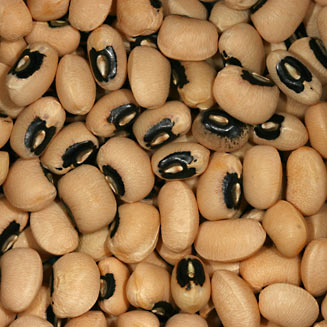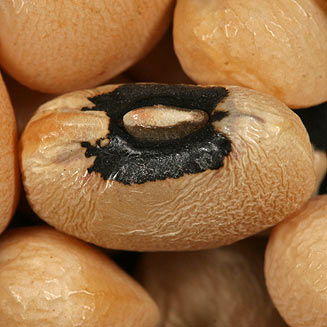Vigna unguiculata (Cowpea, Black-eyed
beans, Black-eyed peas) akkerbone [Afrikaans]; dinawa [Sotho,
Tswana], munawa [Venda]
Life
> eukaryotes >
Archaeoplastida >
Chloroplastida
>
Charophyta > Streptophytina > Plantae (land plants)
> Tracheophyta (vascular plants) > Euphyllophyta > Lignophyta (woody plants)
> Spermatophyta (seed plants) > Angiospermae (flowering
plants) > Eudicotyledons > Core Eudicots > Rosids >
Eurosid I > Fabales > Family: Fabaceae > Subfamily: Papilionoideae
> Genus: Vigna
 |
 |
|
Vigna unguiculata (Cowpea, Black-eyed
beans, Black-eyed peas). [image H. Robertson, Iziko
©] |
Native to Africa, including southern Africa. It is an
important commercial crop in Africa and is also grown as a subsistence crop.
Besides the seeds, the leaves and young pods are also eaten and are considered
nutritious.
Uses
- Seeds are stored dry and used in various dishes.
- The leaves and young pods are used fresh or dry as a
green vegetable. In Setswana and Sesotho
languages, the aerial parts of plants that are eaten as green leafy
vegetables are referred to as morogo and Vigna unguiculata is one of these.
Van der Walt et al. (2009) found that Calcium levels were high in
Vinca unguiculata leaves and there were also reasonable levels of
Magnesium, Iron and Zinc. Selenium levels were low. Carotenoids levels are
reasonably high and similar to those found in spinach. Carotenoids are
transformed into vitamin A in the body and hence are nutritionally
important. Polyphenols concentrations found in Vinca unguiculata are similar to those in commercially grown vegetables.
Polyphenols are important antioxidants and help to prevent thickening of the
arteries (atherogenesis).
Publications
-
van der Walt, A.M., Loots, D.T., Ibrahim, M.I.M. and
Bezuidenhout, C.C. 2009. Minerals, trace elements and antioxidant
phytochemicals in wild African dark-green leafy vegetables (morogo).
South African Journal of Science 105: 444-448.
-
van Wyk, B.-E. & Gericke, N. 2000. People's
Plants. A Guide to Useful Plants of Southern Africa. Briza Publications,
Pretoria.
|
